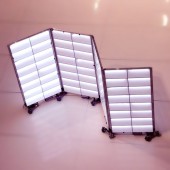Amoeba Wall Dynamical Space Reconfiguration Tool by Honghao Deng |
Home > Winners > #56216 |
 |
|
||||
| DESIGN DETAILS | |||||
| DESIGN NAME: Amoeba Wall PRIMARY FUNCTION: Dynamical Space Reconfiguration Tool INSPIRATION: Inspired by the tiny creature amoeba, we picture future sharing workspace to be hyper-transformable. Imagine the Amoeba Walls are cell membranes of amoebas and other dynamic furniture like Amoeba Tables are the organelles. An empty conference room can be configured into several small team room or individual offices. They can merge into medium size discussion spaces or other spaces with ease based on the context. These transformations resemble the merging and splitting behaviors of amoebas. UNIQUE PROPERTIES / PROJECT DESCRIPTION: Studying from the fluid forms and mechanisms of amoeba, we designed a hyper-efficient wall system that instantly transforms fixed areas into multi-functioning spaces. The walls autonomously shape the room around us in response to our needs such as creating small individual offices, open teamwork spaces, and private meeting rooms within few seconds. This tangible interface allows users to achieve an economical and efficient configurable workspace playfully. OPERATION / FLOW / INTERACTION: In the current iteration, users can manipulate the wall system by dragging nodes of Amoeba Wall simulation on the computer or mobile phone app. We also offer a method to turn music into control signal so that the wall can dance autonomously. In the future iteration, we are developing a computer vision system that let the wall dynamically transform on its own based on the context. PROJECT DURATION AND LOCATION: This project started in March 2016 at MIT Media Lab, Boston Massachusetts. The project is still work in progress to develop the Amoeba Table system to enhance the function of Amoeba Wall system. |
PRODUCTION / REALIZATION TECHNOLOGY: Amoeba Wall's movements are enabled by a system of omni-wheels; by driving individual wheels at different speeds, each node can move in any direction, allowing the wall to translate and articulate. Control is through a computer program which simulates movements and sends commands via Wi-Fi using the MQTT protocol. This system is low-latency, reliable, and can be remotely controlled over the Internet. Wall panels consist of lightweight aluminum and polycarbonate and can be used as a LED interface. SPECIFICATIONS / TECHNICAL PROPERTIES: Compact Mode: Width 1050mm x Depth 380mm x Height 1950mm Unfolded Mode: Width 3920mm x Depth 200mm x Height 1950mm TAGS: Interactive Architecture, Tangible Interface, Sharing Workspace RESEARCH ABSTRACT: With the rapid explosion of population affecting almost every metropolitan city around the world, highly dense cities will soon become the norm. With the goal of creating a dynamically reconfigurable workspace that accommodates a wide range of activities in a small area, we started a design research for several incubator companies focused on creating architectural robotics and platforms that enable creative workspace on demand for a fraction of price and space traditionally required. CHALLENGE: The hardest part is to maximize the control precision using a set of Omni-wheels platforms on different floor conditions. We manage to overcome it by designing auto-correction algorithm based on the feedback from motor encoders and rotation sensors on the nodes. ADDED DATE: 2017-03-01 05:08:03 TEAM MEMBERS (6) : Honghao Deng, Poseidon Ho, Luis Alonso, James Li, Juan Angulo and Kent Larson IMAGE CREDITS: Image Credits: Honghao Deng, Poseidon Ho Video Credits: Honghao Deng, Poseidon Ho |
||||
| Visit the following page to learn more: http://www.honghao.gallery/amoeba/ | |||||
| AWARD DETAILS | |
 |
Amoeba Wall Dynamical Space Reconfiguration Tool by Honghao Deng is Winner in Lighting Products and Fixtures Design Category, 2016 - 2017.· Read the interview with designer Honghao Deng for design Amoeba Wall here.· Press Members: Login or Register to request an exclusive interview with Honghao Deng. · Click here to register inorder to view the profile and other works by Honghao Deng. |
| SOCIAL |
| + Add to Likes / Favorites | Send to My Email | Comment | Testimonials | View Press-Release | Press Kit |
Did you like Honghao Deng's Lighting Design?
You will most likely enjoy other award winning lighting design as well.
Click here to view more Award Winning Lighting Design.








